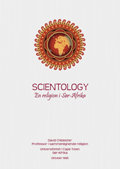1. Church of Scientology, En beskrivelse av Scientology-religionen (Los Angeles: Church of Scientology International, 1993): 2.
2. E.B. Tylor, Primitiv kultur, 2 vol. (London, John Murray, 1920): I:424; Emile Durkheim, Elementære former av religiøse liv, oversatt. Joseph Ward Swain (New York: The Free Press, 1965): 62. En nyttig multidimensjonal «veiviser» for religionsstudier har blitt utviklet av Ninian Smart i et antall publikasjoner, inkludert The Religious Experience of Mankind (Glasgow: Collins, 1971); The Science of Religion and the Sociology of Knowledge (Princeton: Princeton University Press, 1973); The Phenomenon of Religion (London: Macmillan, 1973); og Worldviews: Crosscultural Explorations of Human Beliefs (New York: Charles Scribners, 1983). For ytterligere drøfting om definering av religion, se David Chidester, Gordon Mitchell, Isabel Apawo Phiri og A. Rashied Omar, Religion in Public Education: Options for a New South Africa, 2. utg. (Cape Town, UCT Press, 1994).
3. Emile Benveniste, Indo-European Language and Society (oversatt) Elizabeth Palmer (London: Faber og Faber, 1973, orig. utg. 1969): 522.
4. J.T. van der Kemp, «An Account of the Religion, Customs, Population, Government, Language, History, and Natural Productions of Caffraria», Transactions of the {London} Missionary Society, vol. 1 (London: Bye & Law, 1804): 432.
5. W.M. Eiselen, «Geloofsvorme van Donker Afrika», Tydskrif vir Wetenskap en Kuns 3 (1924/25): 84.
6. Peter Harrison, ’Religion’ and the Religions in the English Enlightenment (Cambridge: Cambridge University Press, 1990): 39.
7. David A. Pailin, Attitudes to Other Religions: Comparative Religion in Seventeenth- and Eighteenth-Century Britain (Manchester: Manchester University Press, 1984).
8. F. Max Müller, Introduction to the Science of Religion (London: Trübners, 1873).
9. I tillegg til arbeidene til Harrison og Pailin som er nevnt ovenfor, har nylige redegjørelser av den historiske fremveksten av de moderne uttrykkene «religion» og «religioner» også blitt stilt til rådighet av Peter Byrne, Natural Religion and the Nature of Religion: The Legacy of Deism (London: Routledge, 1989); J. Samuel Preus, Explaining Religion: Criticism and Theory from Bodin to Freud (New Haven: Yale University Press, 1987); Eric J. Sharpe, Comparative Religion: A History, 2. utg. (La Salle, Illinois: Open Court, 1986); og Michel Despland og Gerard Vallée (redaktører) Religion in History: The Word, the Idea, the Reality (Waterloo, Ontario.: Wilfrid Laurier University Press, 1992). For grundig bakgrunn, se Wilfred Cantwell Smith, The Meaning and End of Religion (New York: Macmillan, 1962): Michel Despland, La religion en Occident: Evolution des idées et du vécu (Montreal: Fides, 1979); og Ernst feil, Religion: Die Geschichte eines neuzeitlichen Grundbegriffs vom Frühchristentum bis zur Reformation (Göttingen: Vandenhoeck og Ruprecht, 1986). For en analyse av den historiske fremskaffelsen av uttrykkene «religion» og «religioner» i det sørlige Afrika, se David Chidester, Savage Systems: Colonialism, Religion, and Comparative Religion in Southern Africa (Charlottesville: University Press i Virginia, tilgjengelig 1996).
10. Angående anti-sekt-bevegelsen, se David Bromley og Anson D. Shupe, The New Vigilantes: Deprogrammers, Anti-Cultists, and the New Religions (Beverly Hills, California: Sage, 1980). I akademisk analyse kan anti-sekt påstander dukke opp igjen i teoretiske modeller som fremstiller nye religioner som psykopatologi, gründerforetak, eller sosiale avvik. Se William Sims Bainbridge og Rodney Stark, «Cult Formation: Three Compatible Models», i Jeffrey K. Hadden og Theodore E. Lang, redaktører, Religion and Religiosity in America (New York: Crossroad, 1983): 35–53.
11. G.P.C. Kotzé o.l., Rapport fra undersøkelseskommisjonen om Scientology for 1972 (Pretoria: Government Printer, 1973): 208.
12. G.C. Oosthuizen, Scientologykirken: Religiøs filosofi, religion og kirke (Johannesburg: Church of Scientology, 1975): 11.
13. L. Ron Hubbard, Skapelsen av menneskelige evner: En håndbok for scientologer, 351.
14. Som et eksempel på denne tilnærmingsmåten, se Hendrik Kraemer, The Christian Message in a Non-Christian World (London: Edinburgh House Press, 1938).
15. L. Ron Hubbard, Phoenix-foredragene (Edinburgh: Publications Organization World Wide, 1968): 35.
16. Ibid., 13.
17. Ibid., 11.
18. L. Ron Hubbard, Vitenskapen om overlevelse: Forutsigelse av menneskelig atferd, 488.
19. L. Ron Hubbard, Scientologi 0–8: Boken om det grunnleggende, 410.
20. L. Ron Hubbard, Scientologi 8–8008, 121.
21. Hubbard, Ceremonies of the Founding Church of Scientology, 7.
22. Jonathan Z. Smith: «Healing Cults», Nye Encyclopaedia Britannica, Macropedia, vol. 8 (Chicago, 1977): 685
23. Henry Clarke Warren, trans., Buddhism in Translations (New York: Atheneum, 1979): 405.
24. Morton Bloomfield, The Seven Deadly Sins: An Introduction to the History of a Religious Concept (East Lansing: Michigan State University Press, 1967).
25. Angående dissonans og harmoni i religiøs etikk, se David Chidester, Patterns of Action: Religion and Ethics in a Comparative Perspective (Belmont, California.: Wadsworth, 1987): 67–105.
26. Hubbard, Vitenskapen om overlevelse, 46.
27. Mircea Eliade, Shamanism: Archaic Techniques of Ecstasy, oversatt av Willard R. Trask (Princeton: Princeton University Press, 1964).
28. Felicitas Goodman, Ecstasy, Ritual, and Alternative Reality: Religion in a Pluralistic World (Bloomington: Indiana University Press, 1988); Where the Spirits Ride the Wind: Trance journeys and other Ecstatic Experiences (Bloomington: Indiana University Press, 1990).
29. For analyse som har svekket tilliten til påstanden om at nye religioner engasjerer seg i «hjernevask», se David Bromley og James Richardson, redaktører, The Brainwashing/Deprogramming Controversy: Sociological, Psychological, Legal, and Historical Perspectives (New York: Edwin Mellen Press, 1983); og Dick Anthony, «Religious Movements and Brainwashing Litigation: Evaluating Key Testimony», i Thomas Robbins og Dick Anthony, redaktører, In Gods We Trust: New Patterns of Religious Pluralism in America, 2. utg. (New Brunswick, New Jersey: Transaction, 1990): 295–325.
30. Scientologykirken, Hva er Scientologi?: Den forståelige referansen om den raskest voksende religion i verden (Los Angeles: Bridge Publications): 245.
31. Ibid., 274.
32. Scientologykirken, Beskrivelse av Scientology-religionen, 8.
33. David Chidester, Patterns of Power: Religion and Politics in American Culture (Englewood Cliffs, New Jersey: Prentice-Hall, 1988): 239–41.
34. Kotzé, Rapport av undersøkelseskommisjonen, 209.
35. Scientologykirken, Reply to the Report of the Commission of Inquiry: «The Missing Report» for the Information of Members of Parliament (Johannesburg: Church of Scientology, 1973): 41.
36. Angitt i Ibid., 43.
37. Scientologykirken, Hva er Scientologi?, 527.
38. Scientologykirken, Referanseveiledning for Scientology-religionen: Svarene på spørsmålene som oftest stilles av Media (Los Angeles: Church of Scientology International, 1994): 22.
39. Citizens Commission on Human Rights, «Psychiatry and South Africa», Creating Racism: Psychiatry’s Betrayal in the Guise of Help (Los Angeles, CCHR, 1995): 18.
40. Klippies Kritzinger, red., Believers in the Future (Cape Town: Verdenskonferanse om religion og fred, Sør-Afrikansk kapittel, 1991).
41. William James, The Varieties of Religious Experience (New York: Macmillan, 1961): 393.
42. Roy Wallis, «Hostages to Fortune: Thoughts on the Future of Scientology and the Children of God», i David G. Bromley og Phillip E. Hammond, redaktører, The Future of New Religious Movements (Macon, Georgia: Mercer University Press, 1987): 80–84; Robert Ellwood, «A Historian of Religion Looks at the Future of New Religious Movements», i ibid., 249–50; Benton Johnson, «A Sociologist of Religion Looks at the Future of New Religious Movements», i ibid., 253–56.





























